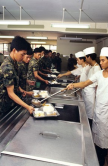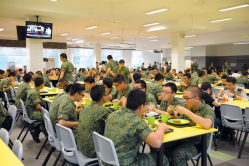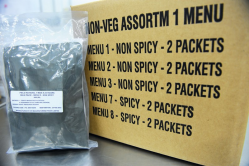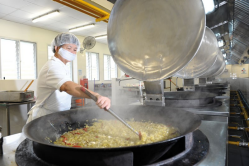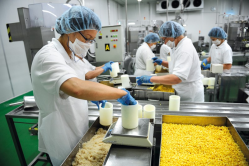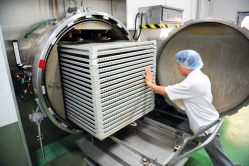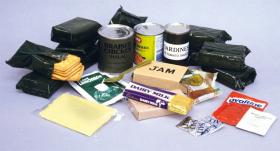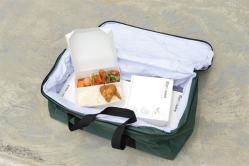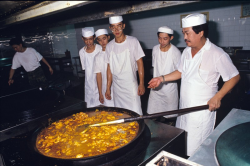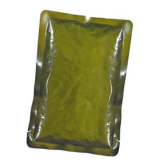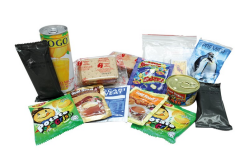OPS & TRAINING
FOOD EVOLUTION
04 Nov 2011
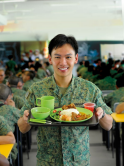
From meals cooked by military chefs to commercially-catered fare, the Singapore Armed Forces (SAF) has come a long way over the years. PIONEER checks out its food transformation efforts.
With meals that feature dishes such as satay, chicken wings, prawn balls, vegetables and cup jelly and served on clean and neatly-aligned tables, you might imagine yourself to be at a food court.
Welcome to the SAF cookhouse.
The days of in-camp food, or fresh rations, comprising just rice with meat and vegetables have long gone. And the food has not stopped evolving since the SAF contracted two commercial caterers - Singapore Food Industries Manufacturing (SFIM) and Foodfare Catering (FFC) - to manage all 60 cookhouses in 1997.
Today, servicemen and women enjoy a wide variety of flavours, ranging from local hawker fare such as prawn noodles, nasi briyani (flavoured rice served with chicken and vegetables) and kway chap (flat and broad rice sheets in dark soy sauce soup, served with beancurd and eggs), to Western favourites like fish and chips.
Going commercial
In 1997, the commercialisation of cookhouses was driven by the need to channel the SAF's limited pool of combat-fit soldiers to the fighting units as a result of manpower shortage caused by falling birth rates, explained Lieutenant Colonel (LTC) Melvin Ang, Head of Supply Services Branch at Headquarters Supply.
This means soldiers can focus on honing their military skills to defend the nation.
On the additional benefits of having commercial caterers, LTC Ang said: "Their knowledge in food preparation and quality assurance has helped us achieve hygiene and nutrition standards that are in line with the national standards set by the National Environmental Agency and the Health Promotion Board (HPB) respectively."
Wider variety
There is now a greater variety of dishes offered to better cater to varying taste buds and prevent menu fatigue. At present, there are more than a thousand recipes from the caterers' menu database to choose from, and new dishes are introduced each month to update the menus.
Military food preparation has also evolved to incorporate food science, where calorie intake is carefully calculated and healthy cooking methods are adopted to ensure the optimal physical and mental performance of the soldiers.
During menu planning, the caterers work closely with the food and beverage (F&B) managers of the SAF as well as the rations team from the Defence Science & Technology Agency (DSTA) to plan meals that adhere to the nutritional requirements specified by the SAF. The requirements are based on the HPB's guidelines ofbetween 2,500 and 3,500 kilo-calories (Kcal) per day depending on the activity level of the serviceman.
To ensure that the advised dietary requirement is met, the DSTA rations team periodically checks and analyses the nutritional content and quality of food samples taken from the cookhouses, said Ms Joyce Tan, Senior Procurement Lead and Food Technologist at DSTA.
Managerial roles
As cookhouses were commercialised, many of the military chefs who used to run them grew into new roles. They now oversee the operations of cookhouses, after undergoing training as F&B managers.
Said 2nd Warrant Officer (2WO) Tan Lay Boo, a military chef-turned-F&B manager from Supply Hub (West), who supervises operations at the Kranji Camp III cookhouse: "The changes in my job scope have allowed me to expand my skill set, which aids in my personal development.
"I learnt invaluable management skills that can be applied to other aspects of my life, beyond work."
Although 2WO Tan no longer cooks for fellow servicemen and women, it still matters to him how satisfied they are with cookhouse meals.
"Based on the feedback we get, we constantly look for ways to improve the taste of fresh rations," said 2WO Tan, who has dedicated 29 years ofhis life to warming the hearts and tummies of soldiers with food.
More options outfield
Field rations also saw an increased variety of meals over the years, just like fresh rations.
They are issued to soldiers during outfield training and operations when the provision of fresh rations is not possible. Each field ration pack feeds a soldier for a day with its configuration of one main pack, one accessory pack and one packet of instant noodles.
About five new dishes are added to the menus of the 24-hour field ration packs every three months, replacing unpopular ones, said HQ Supply Ration Warrant Master Sergeant (MSG) Mok Shao Wei.
Added SFIM Assistant General Manager Tan Yan Ren, who works on the supply of field rations: "We review the menus quarterly and develop new recipes regularly to provide variety. So by the end of each year, you will find that more than half of the food items on the menus have been replaced."
Younger servicemen and women may well be familiar with the green retort pouches containing main dishes and desserts. This, however, has not alwaysbeen the case.
Before 1995, the first generation of field rations comprised canned foods of limited variety, which included baked beans, pork cubes, sardines and braised chicken. Hard tack biscuits were the only source of carbohydrates.
In 1995, the introduction of retort pouches enabled rice and noodles to replace the biscuits as the main source of carbohydrates. The energy content of the field rations increased from 2,400 Kcal to 3,350 Kcal per pack, based on the HPB's dietary guidelines for a male performing vigorous activities.
This transformation was made possible by the use of retort manufacturing technology, which involves the application of high heat and pressure to produce sterilised, shelf-stable and preservative-free products.
As food kept in the pouches does not require reheating prior to consumption, soldiers can enjoy the convenience of eating while on the move.
In addition, the pouches are able to withstand rough handling; the material used is heat resistant and can prevent food spoilage in a hot and humid environment.
Lighter, tougher, greener
In terms of packaging, the retort pouches provide a lighter and more durable alternative to canned items.
Before 1995, two soldiers had to share a 24-hour pack which weighed 2.2kg and consisted of canned food and hard tack biscuits. Now, each pack weighs just 1.6kg and comes packed more energy.
In an effort to go green in 2004, changes were made to the packaging material of the out-ration meal boxes, which are used to pack fresh rations brought into the field for consumption. Biodegradable paper material replaced traditionally-used styrofoam material.
Four years later, compartmentalised meal boxes were introduced to separate the meat, vegetables and rice from one another, which in turn preserves the taste of each dish.
The improvised meal box features a "cover-over-base" cover, which has flaps at two corners of the cover that "lock" the meal box when closed. This ensures that the food is kept warm and safe for consumption for up to four hours when the meal boxes are packed into the green insulated carriers and transported outfield.
By soldiers, for soldiers
Despite significant changes made over the years, HQ Supply, DSTA, SFIM and FFC constantly seek improvements by collecting feedback from servicemen and women.
Soldiers have a say in what is served on the tables and out in the field. In the cookhouses, they get to rate the quality of the meals twice a week at the Point-of-Sale machines, which were introduced in 2002 to automate the meal accounting process.
The F&B managers also talk to diners daily during meal times to gather feedback from the ground.
"In addition, dialogue sessions and surveys are conducted every quarter, where 100 servicemen are randomly selected to suggest improvements to the field rations menu," said MSG Mok.
On the outcome of the dialogue sessions, Mr Tan said: "The entrees used to be mostly rice-based. At present, these meals only constitute about 25 percent of the dishes offered, with pasta and noodles becoming the popular picks. It is a reflection of the taste profile of our soldiers nowadays."
Fresh rations' menus are also discussed with selected soldiers when caterers propose monthly menus to each unit's F&B manager.
The discussion revolves around enhancements that can be made to the menus in terms of aspects such as variety and suitability of the dishes with reference to the units' programmes. For example, when a unit has outfield training on a particular day, caterers are advised to avoid serving "heaty" food like curry chicken for lunch.
Menu development also takes SAF-level activities into account. To prepare servicemen and women for the annual Army Half Marathon this year, the cookhouses served carbohydrate-loading meals four days prior to the event.
As extra carbohydrates allow athletes to perform at their optimal level for a longer time, the usual foods which are higher in fat content, for example chicken thigh and sausages, were replaced by carbohydrates-rich foods such as pasta and sweet corns for a diet that comprised up to 80 percent carbohydrates.
While it is not possible to tailor the menus to each unit's activities and satisfy the taste preference of every soldier, every effort is made to do so. Said LTC Ang: "We strive to cater to soldiers who are involved in different types of training and operations, so that we can provide them with suitable food at the right place and at the right time."
French military and political leader Napoleon Bonaparte once said: "An army marches on its stomach". And so, the mission to ensure that Singapore's fighting force is well fed continues.
"We strive to cater to soldiers who are involved in different types of training and operations, so that we can provide them with suitable food at the right place and at the right time."
- LTC Ang, on how no effort is spared in providing the right food for SAF's soldiers.
Food talk
Tucking into hearty fare at cookhouses is probably one of the most commonly-shared memories among servicemen. Find out what they think about these meals.
"Commercialising the cookhouses was a good move as food quality has improved. The meals are comparable to outside food most of the time. I appreciate that the people serving the food now are much more professional and polite. They wear gloves and masks to ensure hygiene and serve the food professionally."
Corporal (NS) Kok Yeong Haur,
Armour Infantry trooper, 483 SAR
"My favourite dish is chicken rice. Its standard is comparable to those found in the hawker centres. Desserts were rare in the past but its good that they are served more frequently now as they help enrich the overall taste of the meal."
Military Expert (ME) 3 Lee Ker Chia,
Air Force Engineer, 120 Squadron
"Cookhouse food is filling the serving is just right for soldiers who carry out training activities. Food on board the ship tastes good too. Our naval chef can even whip up dishes based on our requests. Sometimes, on rainy days, he makes hot soup for us to warm our tummies and boost our morale."
ME 1 Ashwin s/o Suresh,
Marine Systems Operator, RSS Freedom
"Fresh rations are something that I look forward to after every outfield exercise. I feel at ease knowing that my energy is sufficiently replenished with the well-balanced meals."
Lieutenant Faroz Marzoki,
Platoon Commander, 4th Battalion, Singapore Infantry Regiment
SAF food supply milestones
1967
The cookhouses were operated entirely by the SAF's military chefs and their assistants. This working model was, however, not sustainable due to limited manpower resources.
1988
A chilled-cooked food system was implemented throughout the SAF. Under this system, commercial caterers preparedchilled-cooked meals which were then delivered to the SAF units to reheat for serving.
1995
With the use of the retort process, lighter retort pouches replaced the heavy and bulky canned food as field rations.
1997
All cookhouses were commercialised.
2002
Electronic Cookhouse system replaced the tedious manual meal accounting system.
2006
Commercial-off-the-shelf field ration accessory packs were introduced to provide variety. They contain snacks and beverages that can be found in supermarkets.
2008
Environmentally-friendly and compartmentalised out-ration meal boxes were used.
2010
The Weekend Meal, which has greater menu variety, was created for personnel on weekend duty.
2011
Carbohydrate-loading meals were introduced in cookhouses for the annual Army Half Marathon.
ALSO READ IN OPS & TRAINING
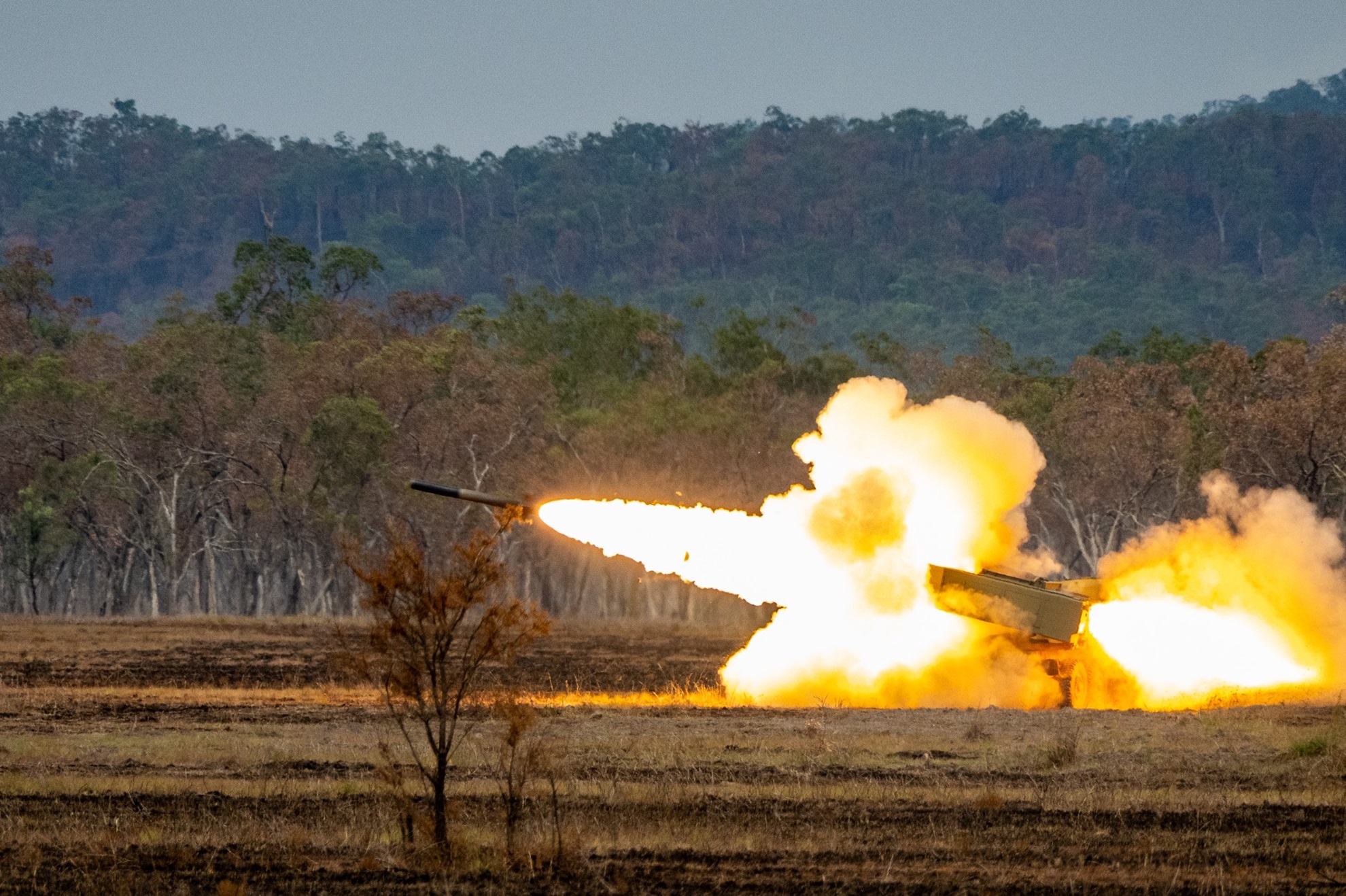
Exercise Wallaby 2025: To see better, shoot faster
31 Oct 2025
The SAF focuses on complex strike missions and multi-domain integration in Exercise Wallaby 2025, the 35th edition of its largest unilateral overseas exercise.
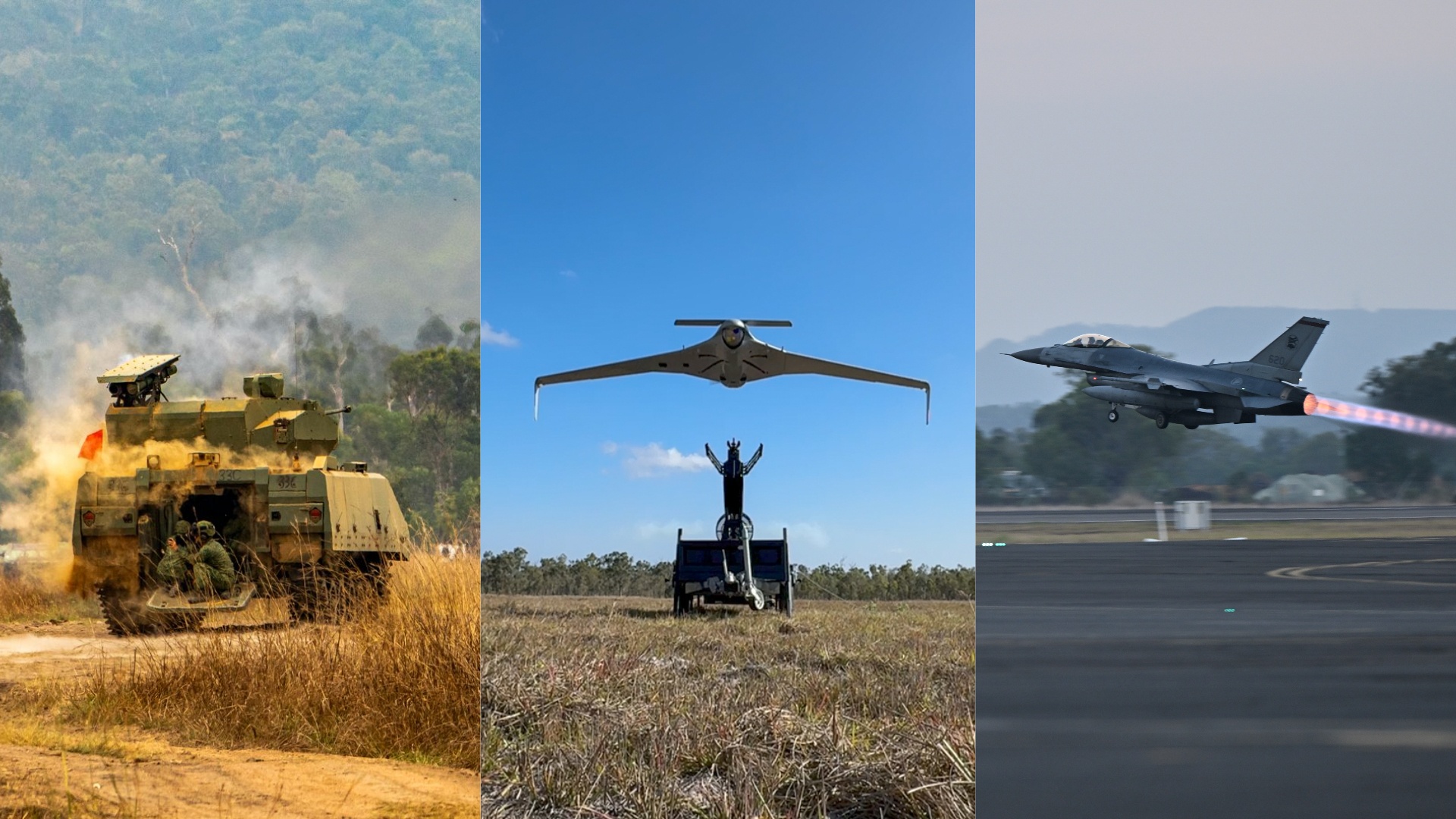
Ex Wallaby 25 – Greater Integration and Complexity
25 Oct 2025
The 35th edition of the SAF’s largest unilateral overseas exercise is an opportunity for expanded scale and deeper integration towards an effective, networked fighting force.

Ex Forging Sabre ramps up use of unmanned assets in integrated strike operations
12 Sep 2025
In this 10th edition of Exercise Forging Sabre, the SAF sharpened its cutting edge for the dynamic modern battlefield, with expanded integration between manned and unmanned platforms.


